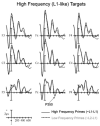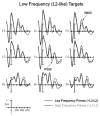The role of subjective frequency in language switching: an ERP investigation using masked priming
- PMID: 21264577
- PMCID: PMC3331680
- DOI: 10.3758/s13421-010-0006-7
The role of subjective frequency in language switching: an ERP investigation using masked priming
Abstract
Two experiments examined the nature of language-switching effects in a priming paradigm with event-related brain potential (ERP) recordings. primes and targets were always unrelated words but could be either from the same or different languages (Experiment 1) or from the same or a different frequency range (Experiment 2). Effects of switching language across prime and target differed as a function of the direction of the switch and prime duration in Experiment 1. Effects tended to be stronger with 100-ms prime durations than with 50-ms durations, and the expected pattern of greater negativity in the switch condition appeared earlier when primes were in L1 and targets in L2 than vice versa. Experiment 2 examined whether these language-switching effects could be due to differences in the subjective frequency of words in a bilingual's two languages, by testing a frequency-switching manipulation within the L1. Effects of frequency switching were evident in the ERP waveforms, but the pattern did not resemble the language-switching effects, therefore suggesting that different mechanisms are at play.
Figures








Similar articles
-
Code-switching effects in bilingual word recognition: a masked priming study with event-related potentials.Brain Lang. 2008 Jun;105(3):161-74. doi: 10.1016/j.bandl.2007.11.006. Epub 2008 Jan 8. Brain Lang. 2008. PMID: 18191445 Free PMC article.
-
Hemispheric differences in strong versus weak semantic priming: evidence from event-related brain potentials.Brain Lang. 2007 Jan;100(1):23-43. doi: 10.1016/j.bandl.2006.06.117. Epub 2006 Sep 5. Brain Lang. 2007. PMID: 16908058
-
Testing asymmetries in noncognate translation priming: evidence from RTs and ERPs.Psychophysiology. 2011 Jan;48(1):74-81. doi: 10.1111/j.1469-8986.2010.01048.x. Psychophysiology. 2011. PMID: 20557483 Free PMC article.
-
Language switching mechanisms in simultaneous interpreters: an ERP study.Neuropsychologia. 2004;42(12):1636-56. doi: 10.1016/j.neuropsychologia.2004.04.013. Neuropsychologia. 2004. PMID: 15327931 Clinical Trial.
-
Meaning first: a case for language-independent access to word meaning in the bilingual brain.Neuropsychologia. 2013 Apr;51(5):850-63. doi: 10.1016/j.neuropsychologia.2013.01.017. Epub 2013 Jan 31. Neuropsychologia. 2013. PMID: 23376051 Free PMC article.
Cited by
-
Evidence for Separate Contributions of High and Low Spatial Frequencies during Visual Word Recognition.Front Hum Neurosci. 2017 Jun 22;11:324. doi: 10.3389/fnhum.2017.00324. eCollection 2017. Front Hum Neurosci. 2017. PMID: 28690505 Free PMC article.
-
A Systematic Review over the Effect of Early Infant Diet on Neurodevelopment: Insights from Neuroimaging.Nutrients. 2024 May 30;16(11):1703. doi: 10.3390/nu16111703. Nutrients. 2024. PMID: 38892636 Free PMC article.
-
When less is more: feedback, priming, and the pseudoword superiority effect.Brain Res. 2011 Apr 22;1386:153-64. doi: 10.1016/j.brainres.2011.02.050. Epub 2011 Feb 23. Brain Res. 2011. PMID: 21354110 Free PMC article.
-
A review of control processes and their locus in language switching.Psychon Bull Rev. 2015 Dec;22(6):1630-45. doi: 10.3758/s13423-015-0836-1. Psychon Bull Rev. 2015. PMID: 25917142 Review.
-
The Role of Orthotactics in Language Switching: An ERP Investigation Using Masked Language Priming.Brain Sci. 2019 Dec 31;10(1):22. doi: 10.3390/brainsci10010022. Brain Sci. 2019. PMID: 31906199 Free PMC article.
References
-
- Alvarez RP, Holcomb PJ, Grainger J. Accessing word meaning in two languages: An event-related brain potential study of beginning bilinguals. Brain and Language. 2003;87:290–304. - PubMed
-
- Costa A, Santesteban M. Lexical access in bilingual speech production: Evidence from language-switching in highly proficient bilinguals and L2 learners. Journal of Memory and Language. 2004;50:491–511.
-
- Dalrymple-Alford EC. Language-switching during bilingual reading. British Journal of Psychology. 1985;76:111–122.
-
- Dijkstra T, van Heuven WJB. The architecture of the bilingual word recognition system: From identification to decision. Bilingualism: Language & Cognition. 2002;5:175–197.
Publication types
MeSH terms
Grants and funding
LinkOut - more resources
Full Text Sources

